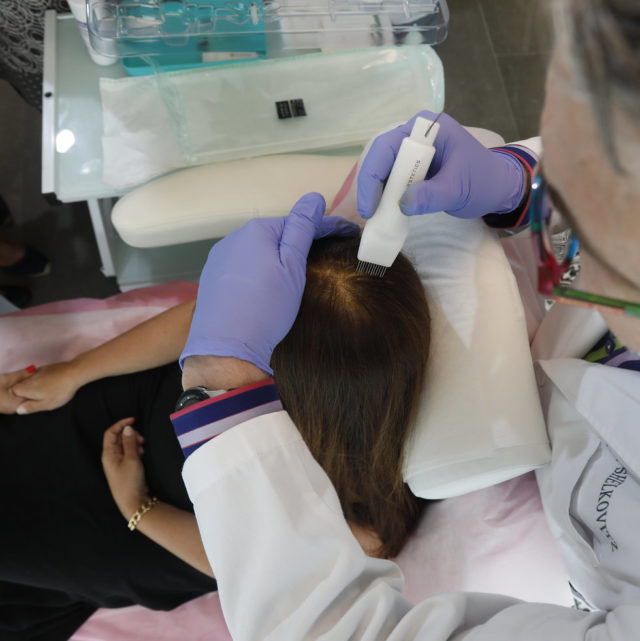The synthetic hair made of non-repulsive materials, with tiny stents, which are known from heart disease, Suitable for women going home with the final hair look; Not suitable for men
Are you seeing lots of hair left around in the shower, on your pillow or on your hairbrush? If you are shedding hair a bit too much like your Labrador puppy then this new Israeli invention may be for you.
In a 45-minute procedure, Israeli technology company Hairstetics has successfully developed synthetic hair implants using tiny stents, borrowing techniques from arterial repair in heart disease.
Hair loss and thinning of hair effect 90 percent of all men and 45 percent of women. This new process will, however, be available primarily only for women, as it requires cover from adjacent natural hair at least seven inches long.
Hila Selig (44), a cosmetologist from Rishon Lezion, Israel, was one of them. With some trepidation, Hila stepped into Dr. Tzahi Schalkowitz’s clinic to go through the first stage of a synthetic hair implant. Dr. Schalkowitz is a dermatologist who has been dealing with hair loss problems and providing various treatments for many years. He is one of three doctors in Israel who are currently performing this new synthetic hair implant process – it is not really a “transplant” as it is not natural hair coming from someone else.
“After my pregnancies I had serious hair thinning,” Hila says, “I also have a genetic predisposition. Both my parents suffered from thinning hair and baldness. Natural hair transplants have not suited me because they involve shaving. Of course, I fear pain, God forbid. But according to what I’ve read about this innovation, there’s no risk. But my family know that I am willing to try anything,” she laughs.
When I hold hair strands like the ones that are planted in Hila’s head (currently one can choose one of seven colors), I discover the smooth, soft, yet silky touch almost of natural hair. The sheen is slightly noticeable compared to the natural ones, especially under strong lighting, which increases with the light tones.
Yael Inbar, who runs Dr. Schalkowitz’s office, has herself gone through the process. She challenges me to identify the synthetic hairs that have been added to her hair. I’m having a hard time.
“The implant was a pretty pleasant experience,” she says. “The anesthetic injections were a bit bothersome at first, but then it didn’t hurt. Then it’s done, you get up with new hair and an immediate new look unlike natural hair transplants, which require a period of healing and waiting for the hair to grow again.”
Dr. Schalkowitz explains that there are also limitations. “Currently, these implants are usually suitable only for women. For the hair to lie properly and not stand up, it is necessary to fit into existing hair at least six to seven inches long. It is not suitable for most men in the age of short trimmed hair”.
Behind the transplants of Synthetic Hair and Hairstetics is Dvir Keren, the inventor and entrepreneur of medical equipment who has previously founded a series of companies that have patented various inventions in cardiology and surgery. How did he come to hair? “I was looking for a huge market,” he says, “I saw the upturn in the Botox wrinkle market and identified the hair transplant market as the next destination. All traditional methods have identified painful processes, anesthesia, long-awaited results, and technology that has not changed in years.
Dvir wanted a method of getting into the clinic and going out with hair in half an hour. “I built my 25 hair device. It’s a two-cartridge syringe. Every 12 or 25 synthetic hairs are attached to hollow needles. The hairs are made from surgical sewing threads. At the end of each hair is a miniature stent that fixes it to the scalp, made of nitinol, the alloy that revolutionized the field. Surgical cardiology is found in stents that are implanted in heart patients, “he says.
More than $ 10 million has been invested in the company to date. The first implants were performed in India. Then more were done in France. Today seven-colors of hair are offered, with white being developed. During the injection, the cartridge inside the syringe opens, the stent that functions as an implant and holds its hair opens into two arms, and the hair penetrates the scalp. The process is simple. Do not shave the hair, just disinfect the scalp transplant area and the doctor injects adrenaline – a superficial anesthetic. Preparation takes three minutes, complete procedure 20 minutes.
who is it for?
“To 93 percent of the population,” Keren argues, “mainly women who suffer from hair thinning and baldness. Not suffer from autoimmune diseases, because we have no clinical experience for them, and so we do not. Nor do people with psoriasis who can go through the process have reduced chances of success. “.
And what about those whose hair has fallen out of chemotherapy?
“We made one case in Paris,” Keren replies, “But because we have no experience with them, we prefer not to focus on this niche.”
In Israel, three doctors are already working on the new method. So far there are seven more in the world. Dr. Shalkovitz, as mentioned, is one of them. “Dvir came to me two and a half years ago,” he says, “as soon as I saw the product I recognized the potential. They also had enough data to show me from other countries. The only thing I needed was approval from the Ministry of Health. After it was accepted, I started the transplant. To date, I have performed the procedure for several dozen patients. When I talk about the method, even among those who come to the clinic for other reasons, there is no woman who has no shine in her eyes.”
According to the Ministry of Health’s approval, valid until 2020, six new medical centers (including clinics) could be involved in the new process. The Ministry of Health makes it clear that not only has the device been approved, but also the synthetic implants have undergone biocompatibility tests – indicating that the materials are suitable for insertion into the human body without rejection or infection. The office only examined the safety of the product and not its effectiveness, a component not required in these tests.
And what about the medical safety of the process? “If we find a problem, the hair can be immediately removed. Both types of our synthetic hair, and the stents we use, are currently already also used in the surgical industry and have been for decades.
HairStetics has also received CE, the EU’s considered approval, which allows the product to be sold in all European countries as a medical product without restrictions, and, as mentioned, with the approval of the Ministry of Health under the AMR.
Of course, as with any such product, the skill and care of the clinician deploying it are of as much importance as the procedure itself, and anyone considering it should do their own due diligence carefully as to who may be qualified to deliver it and has adequate experience in its use.
Read more about: HAIR, Hairstetics, Israeli invention, Israeli Technologies, Synthetic hair, Synthetic Hair Transplant






